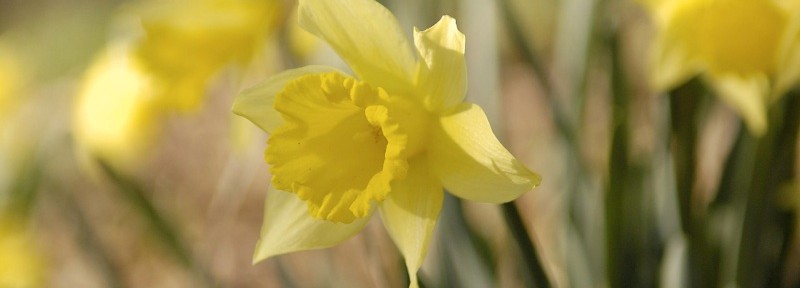My daughter Abigail got a call this week from a poetry-quoting woman up in Appleby. Because my number was left out of the phonebook this year, Mrs. Connie Fletcher had called her in search of me to talk about flowers. Normally, Abigail does not much like taking my phone calls (only being moderately interested in gardening), but she does like poetry and this woman quoted poetry, Wordsworth to be exact. My daughter said she liked this woman instantly, that I would definitely want to visit with her. Well, I did. Mrs. Fletcher has a yard full of Lent Lilies (Narcissus pseudonarcissus).
I am sometimes amazed about what can be found growing in the countryside of East Texas. The Lent Lily is one of those things. This species of the genus Narcissus can be found growing wild across France, Spain and even into England. This wildling from Europe has made itself a home (of all places) here in East Texas, and it has brought delight to the human heart for centuries.
The Lent Lily, so called because it blooms early around Lent each year, is also known by names like the “Early Virginia Daffodil” and “Early Yellow Trumpet.” I suppose it goes without saying that it is one of the first of its genus to bloom each spring.
The Lent Lily can be identified sometimes around old homesites because it is generally shorter in statue than any of the other narcissus- under 8 inches. Blooms can be 2 to 3 inches in length and sport a very prominent, deeper yellow trumpet, and the petals are pale yellow and slightly “untidy” in nature. The large, deep yellow trumpet of the bloom sets it apart from its kin. N. pseudonarcissus sets viable seed which means it is not dependent upon people to move it around or propagate it.
Now, let’s get to the poetry quoted by Mrs. Fletcher’s. The Lent Lily growing in her yard out in Appleby is the plant that inspired poets like Wordsworth and Keats. Wordsworth wrote of an afternoon wandering in the countryside,
I wandered lonely as a cloud
That floats on high o’er vales and hills,
When all at once I saw a crowd,
A host, of golden daffodils;
Beside the lake, beneath the trees,
Fluttering and dancing in the breeze.
The English gardener Judith Berrisford said of the Lent Lily, it “is the most in keeping with the spirit of the wild garden…among the most exciting and challenging colonizer.”
If you ever come across an old homesite in East Texas where these bulbs have spread themselves out over the years, you can identify with Wordsworth’s words “Ten thousand saw I at a glance, tossing their heads in sprightly dance…a poet could not but be gay in such a jocund company.”
I hope you spend some time “wandering” the countryside this February. If you do, be sure to look for the Lent Lily. It will be one of the first narcissus of the season to bloom. When our seasons are normal and if it blooms true to form, this wildling from Europe appears around the fast of Lent.

